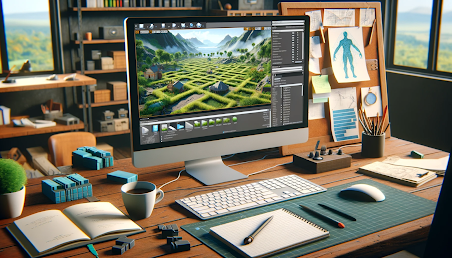The world of game development Companies has evolved
dramatically over the years, and one of the most significant
advancements in this field is the creation of open-world games.
These games offer players a vast, interactive environment that
they can explore at their own pace, and Unreal Engine has
emerged as one of the leading tools for crafting such expansive
and immersive worlds. Unreal game development leverages the
engine's powerful and user-friendly features, making it a top choice
for both indie developers and large studios.
The Power of Unreal Engine in Open-World
Game Creation
Unreal Engine stands out for its exceptional graphics quality
and powerful physics engine, key elements in crafting expansive
open-world games. Its sophisticated rendering features enable the
design of breathtakingly lifelike settings, ranging from vast cityscapes
to rich, green forests. Moreover, Unreal Engine's extensive suite of
tools, notably its Blueprint visual scripting system, empowers developers
to quickly prototype and refine their concepts, even with limited coding
experience. This combination of high-end graphics and user-friendly tools
makes Unreal Engine a premier choice for developing visually stunning
and interactive open-world games.
Planning Your Open World Game
Before delving into the technical aspects, establishing a concrete vision
for your game is essential. Outline the game’s environment, narrative,
and fundamental gameplay elements. This phase typically involves
extensive brainstorming and conceptualization to determine the game’s
thematic direction, storyline, and the overall player experience you aim
to create.
Leveraging Unreal Engine's Landscape Tools
In the initial stages of unreal game development, the creation of terrain
is a pivotal task. The Unreal Engine offers a robust Landscape tool,
designed to facilitate the efficient crafting of expansive terrains. With
this tool at your disposal, you can shape diverse landforms such as
mountains, valleys, and bodies of water, laying down the fundamental
physical layer of your game's open world. It's important to ensure that
the terrain is not only aesthetically pleasing but also plays a practical role,
impacting both gameplay dynamics and the exploration experience of
the player.
Populating the World with Assets
A vibrant open world extends beyond mere terrain; it requires an array
of objects, structures, flora, and characters to truly animate it. The Unreal
Engine Marketplace stands as a treasure trove, brimming with a wide
variety of assets that can enhance your game’s environment. Nevertheless,
for adding a distinct flair, consider crafting bespoke assets or engaging game
developers who specialize in 3D modeling and texturing. Their expertise
can add unique elements to your game, setting it apart in the realm of
open-world experiences.
Creating Realistic Environments with Lighting
and Weather Effects
Illumination is a critical element in establishing the ambiance and feel of your
game. The dynamic lighting capabilities of Unreal Engine enable the simulation
of different times of day and meteorological conditions, infusing the environment
with depth and authenticity. Incorporating a cycle of day to night and a range of
weather scenarios can profoundly amplify the player's engagement and sense of
immersion within the game's universe.
Implementing AI and NPCs
An integral part of any open world are the non-player characters (NPCs)
and various wildlife elements. With the advanced AI tools provided by
In unreal Engine, developers can craft NPCs with distinct behaviors and
modes of interaction. These characters are pivotal in enhancing the game's
storyline and environment, as they can offer quests, engage in trade with
players, or serve as opponents, thereby adding depth and richness to the
overall narrative and setting of the game.
Optimizing Performance
Open-world games require significant performance resources. To facilitate
smooth gameplay, Unreal Engine provides a range of optimization features.
These features include settings for level of detail (LOD), efficient culling
mechanisms, and judicious resource management. Continuously
monitoring and refining the game's performance is a critical aspect
of the development process, ensuring the game runs efficiently at
every stage.
Testing and Iteration
A critical component of game development involves the continuous
testing and refinement of your design. Gathering feedback is key to
this process, and fortunately, Unreal Engine facilitates swift iterations.
Conducting frequent playtesting allows for the timely detection of
glitches and areas needing enhancement, significantly elevating the
game's overall quality. This iterative cycle ensures that each aspect
of the game is polished and fine-tuned for the best player experience.
Hiring Expertise
Although Unreal Engine provides a user-intuitive interface, the
endeavor of crafting an open-world game is an immense undertaking.
This process typically necessitates a team comprised of individuals
with a wide array of talents. Should your project demand particular skill
sets, it's advisable to explore the possibility of engaging game developers
who excel in specialized fields such as AI development, 3D artwork
creation, or auditory design. Platforms dedicated to freelancing and online
communities focused on professional game development present ideal
starting points for recruiting such specialized expertise.
Conclusion
Constructing an open-world game using Unreal Engine is an adventure
that melds imaginative design with technical expertise. Utilizing the robust
capabilities of Unreal Engine and engaging proficient developers as needed,
you have the opportunity to craft an absorbing and captivating open-world
game that shines in the dynamic gaming industry. It's crucial to recognize
that triumphant unreal game development is an amalgamation of creative
vision, technical ability, and a persistent dedication to refine and enhance
your work continuously.
Read more blogs about the gaming industry:
Integrating AR and VR into Mobile Games with Unreal Engine
The Role of Storyboarding in 2D and 3D Animation Projects
The Benefits of Blockchain in RPG Game Development


.jpg)

No comments:
Post a Comment